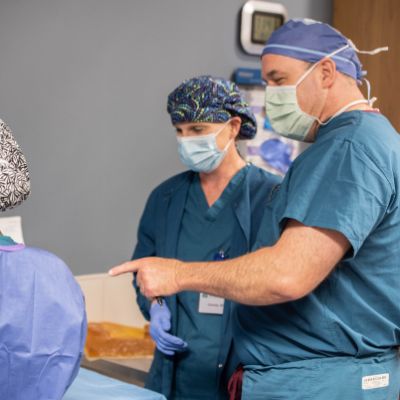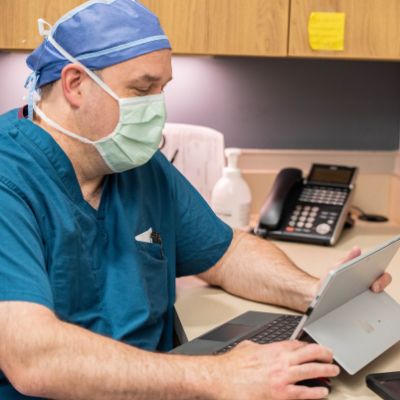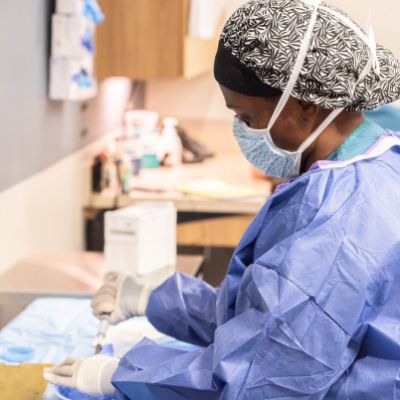Glaucoma is a slow-moving disease that slowly steals your sight by damaging the optic nerve of your eye. While oral medication and eye drops for glaucoma are available, you may eventually reach the point that you require surgery. Knowing what treatments are available or appropriate for you, how long recovery takes, and success rates for glaucoma surgery will allow you to make an informed decision with your doctor.
To help you feel prepared, we’ll look at the various facets of glaucoma surgery, including:
- Types of glaucoma surgery
- Recovery time
- Success rates
- Side effects
- Cost
Types of Glaucoma Surgery
You have plenty of options for glaucoma surgery in Knoxville. At Tennessee Valley Eye Center, our team of surgeons stays on top of the latest techniques and technology to provide the best glaucoma treatment available. They will use this information as well as their experience to craft a treatment plan that is specific to your disease and maximizes your chances of success in the safest, most efficient way possible.
Minimally Invasive Glaucoma Surgery (MIGS)
Over the last ten years, there have been significant advancements in the options for glaucoma surgery. Our surgeons have been on the forefront of this advancement in the field of minimally invasive glaucoma surgery, or MIGS for short. MIGS procedures differ from traditional glaucoma surgeries such as trabeculectomy and larger tube shunts. These traditional surgeries are highly effective but as much as one in three may have complications and one in five may require reoperation at some point.
Unlike more traditional forms of surgery that require larger incisions and longer recovery time, the microincisional approach typically allows for quicker recovery and shorter procedure times albeit with sometimes more modest pressure reduction. This helps to reduce the risk of complications that are more common in traditional forms of glaucoma surgery.
MIGS is actually a group of surgical procedures that may work in different ways but share the common features of being minimally invasive and effective while providing rapid recovery and a high safety profile. Examples of MIGs and other non-incisional options offered by our doctors include:
- Laser treatment of the trabecular meshwork (TM), the eye’s natural plumbing system along with the Schlemm’s canal, the eye’s natural drainage system.
- Dilation and opening of the Schlemm’s canal/TM
- Stenting of the Schlemm’s canal
- Micro-stents that bypass the natural plumbing system
The main benefit of these procedures is patient safety. All surgeries come with some level of risk, but MIGS offers a safe option than traditional glaucoma surgical approaches, combined with the opportunity for pressure reduction to treat glaucoma.
Laser Trabeculoplasty
Laser trabeculoplasty uses a special contact lens and laser to treat glaucoma. The laser is focused through the contact lens onto the drainage system within the eye. The energy from the laser promotes the flow of liquid and reduces the intraocular pressure within the eye, helping to preserve your vision.
Also known as selective laser trabeculoplasty (SLT), this medical treatment has similar outcomes as eye drops for glaucoma. In fact, the LiGHT study, completed in 2019, actually showed that SLT was more effective and cost efficient than drops as an initial treatment for open angle glaucoma.
It’s still common for eye specialists to prescribe eye drops for glaucoma treatment. However, the advancement of safer procedures has allowed for more aggressive treatment earlier in the disease to improve patient satisfaction and outcomes.
Eye drops can sometimes still be necessary following SLT depending on the level of glaucoma damage or disease. Fortunately, even in these circumstances fewer drops may be necessary to treat the eye disease because of the laser effect.
This is especially helpful if you struggle with:
- Using the eye drops as directed or remembering to use them
- Affordability of prescription drops
- Side effects
- Allergies
Glaucoma treatment is based on the individual, so laser trabeculoplasty won’t be the best form of eye care for everyone. And even if it is the right choice for you, results generally only last three to five years. If you qualify, as noted above, it may be recommended as a primary form of therapy. Discuss your options with your eye doctor to determine the best form of treatment for you.
Schlemm’s Canal Procedures

One form of MIGS procedure involves attempting to restore the eye’s natural outflow plumbing system through the trabecular meshwork and Schlemm’s canal. Much like a heart doctor can place a stent in a blocked artery or balloon open the blockage, doctors now also have these capabilities within the eye. These procedures do not involve the conjunctiva (white portion of the eye) like more traditional glaucoma surgeries, which allows for other treatment options in the future, if needed.
This also reduces some of the infection risks and other complications associated with surgery involving the conjunctiva. All of these procedures are performed utilizing a small incision through the clear cornea and many can be done with or without cataract surgery.
Dilation and Goniotomy of Schlemm’s Canal
This grouping of MIGS procedures restores the natural drainage system of the eye either by unroofing a portion of this system or dilating the outflow canal, vessels and collector channels (or both). These procedures, like the stents above, can be performed with cataract surgery but may also be performed by themselves for all levels of glaucoma. They have been shown to effectively lower intraocular pressure and reduce drop usage, like the stents, without leaving behind any implants.
Stenting of Schlemm’s canal
At the time of cataract surgery, a small incision is made to remove the cataract. As noted above, one option for treatment involves placing a small stent within the outflow system of the eye, which helps reduce the pressure in the eye. The different versions of these stents are all smaller than an eyelash. They will add less than approximately 5 minutes typically to a cataract surgery but allow opportunity for lowering of intraocular pressure and reduction of eyedrop use.
Stents currently in use have shown more than 75% of patients have reduced intraocular pressure greater than 20%. Patients who receive one of these stents are significantly more likely to be free of medication use for their glaucoma two years after cataract surgery versus cataract surgery alone.
Xen Gel Stent
The Xen gel stent is a 7 mm long implant made of porcine collagen. It meets the criteria listed above for MIGS surgery but utilizes the same bypass pathway that the traditional glaucoma surgery, trabeculectomy, uses to lower the intraocular pressure through the subconjunctival space.
It has been shown through the APEX study to lower intraocular pressure safely and effectively with a better safety profile than the more traditional surgeries that are completed under the conjunctiva. It can also be completed with or without cataract surgery and is often utilized in multiple levels of glaucoma care, particularly when other MIGS or drops have failed to adequately control eye pressure.
Laser Peripheral Iridotomy and Narrow Angle Glaucoma
Eye surgeons check your eyes’ drainage systems using gonioscopy. In this procedure, a mirror is used to see if the angles in the system are:
- Open
- Narrow
- Closed
If the angle is open then they will be able to see most, if not the entire, drainage system and iridotomy would not be needed. Narrow angles make it difficult to observe the entire system, only letting surgeons see parts of it. In narrow angle glaucoma, the outflow system is typically more crowded by structures or can close off completely leading to an emergency where the pressure rises quickly.
These attacks of angle closure can cause you to experience:
- Clouded or decreased vision
- Redness
- Severe pain
- Nausea and vomiting
Acute angle-closure glaucoma can also result in permanent damage to your optic nerve. As the nerve becomes increasingly damaged, the fibers begin to die and you begin to lose your sight.
While eye drops and oral medicines can help lower your eye pressure, structural treatment is often needed via surgery in the setting of narrow angle. There are two options that are often discussed by your eye surgeon. In some settings, laser peripheral iridotomy is performed. Think of the hole made by the laser as an escape hatch for the fluid inside your eye, balancing your eye pressure and preserving your vision.
Laser peripheral iridotomy (LPI) treats the high eye pressure associated with narrow-angle glaucoma by creating a hole in the iris using a laser. This laser allows the clear fluid inside the eye (aqueous humor) to bypass the blockage through an alternate path and flow freely between chambers often deepening the narrow area. The result is significantly decreased eye pressure to help protect your vision.
More recently, the EAGLE study has shown that early lens extraction with a cataract surgery is the best option for treatment of narrow-angle or angle-closure glaucoma. Even if the cataract is not causing other visual issues, your glaucoma provider may discuss removing the lens to provide more space for the natural outflow system.
Trabeculectomy

Trabeculectomy has long been the gold standard of glaucoma treatment. Even now, with safer options available, it may still be warranted as treatment of severe open angle glaucoma. This surgery involves making an incision in the conjunctiva (thin, clear layer covering the white part of the eye) and then creating a flap of the sclera.
An opening is made under this flap that allows liquid to drain from inside the eye into the subconjunctival space. The closure of the flap controls how much fluid flows through this area, creating a bleb or bubble that is often noted underneath the upper eyelid.
The clear fluid inside doesn’t escape through the bubble so there’s no excessive tearing. Instead, blood vessels within the eye absorb the liquid. The bubble itself usually goes unnoticed by others thanks to being made underneath the upper eyelid.
Unlike laser trabeculoplasty, trabeculectomy is rarely an eye surgeon’s first choice of treatment. Treatment usually begins with eye drops or laser surgery in their office and may be proceeded by different MIGS options. Unfortunately, you may require trabeculectomy if other forms of treatment can’t adequately lower your eye pressure.
As with all types of glaucoma surgery, trabeculectomy does not restore vision that has been lost. It’s designed to reduce increased pressure within your eye so that you preserve what vision you still have. As has been noted before, while trabeculectomy is a very effective surgery for lowering eye pressure, it does come with a much higher risk of complication than the surgeries discussed previously.
Aqueous Tube Shunt
Aqueous tube shunts are flexible drainage devices designed to reduce pressure within the eye. They work by diverting the liquid within the eye to an external reservoir. There are different types of tube shunts available, with the Ahmed Glaucoma Valve being one of the more common options. It’s designed to not break down in the body to provide long-term treatment.
The Ahmed shunt is shaped similarly to a computer mouse that has a tube coming out of the end of it. The tube goes into the front of the eye (the anterior chamber) while the rest of it lays on the surface of your eye underneath the conjunctiva and eyelid. Fluid from inside the eye is absorbed into the eye’s veins and directed out of the eye cavity by the shunt.
Shunts can be recommended in many circumstances as a first or second line treatment. Some common examples would be in certain glaucoma types (neovascular, inflammatory, traumatic) or when other surgeries have failed previously or are at higher risk of failure.
Talk to your surgeon about treatment options and if an aqueous eye shunt would be best for you. They will help you weigh the risks and benefits, as well as be knowledgeable about the latest studies on tube shunts versus trabeculectomy for glaucoma.
ExPRESS Mini Shunt
ExPRESS Mini shunt is a newer variation on the traditional trabeculectomy. The ExPRESS involves a flap creation like a trabeculectomy but does not require all of the steps of a traditional trabeculectomy due to the placement of a small stent underneath the flap.
One systematic study found that the ExPRESS mini shunt showed equivalent pressure reduction as traditional trabeculectomy. What may make it preferable to trabeculectomy is that it comes with a somewhat quicker recovery period.
You can rest assured that you’re getting the best glaucoma surgery in Knoxville when you choose Tennessee Valley Eye Center. With a combined 520 years of surgeon experience and 30 surgeons on our medical team, you can trust that we will be able to determine the best form of surgical treatment for your glaucoma.
Click here to learn more about glaucoma and its treatment options!
Recovery Time
In most cases, patients begin to notice improvement anywhere between days and weeks after glaucoma surgery. However, rare cases do occur where recovery takes months. It’s important to keep in mind that recovering from glaucoma surgery can vary depending on the type of procedure you undergo.
For instance, the recovery time for MIGS is often much shorter than more invasive forms of surgery and requires less tissue removal from the eye. Alternatively, traditional surgeries such as trabeculectomy, the ExPRESS mini shunt, and various aqueous tube shunts are considered more major operations. This means that it will take longer to recover from them than less invasive surgical procedures.
On the other hand, the type of surgical procedure you undergo isn’t the only factor in recovery time. Other factors include:
- The severity of your glaucoma
- Medications you’re taking, such as blood thinners
- Your individual eye’s reaction to surgery
Talk to your eye doctor about what they anticipate your glaucoma surgery recovery time to be. This will give you realistic expectations about your glaucoma surgery and motivate you to follow their directions for recovery as closely as possible.
Success Rates
As with recovery times, the success rate of glaucoma surgery can vary depending on the type of procedure you get. For instance, while MIGS provide more modest pressure reduction, their safety profile often makes them the preferred option. More invasive procedures produce a more significant reduction in eye pressure.
Be sure to discuss the success rates of glaucoma surgery with your eye surgeon. They will be able to give you a clearer idea of what to expect, as well as detailed instructions on how to have the most successful surgery possible.
Side Effects

All surgical procedures come with a certain level of risk, and your glaucoma surgery is no different. What’s important to remember is that glaucoma surgery has a very high success rate when it comes to reducing high eye pressure. It’s also important to note that these complications are rare, but you should still take the time to discuss them with your surgeon.
Possible rare complications from glaucoma surgery include:
- Vision loss
- Bleeding
- Infections
- Low eye pressure
- Scarring
- Cataracts
Side effects of glaucoma surgery are rare. Nonetheless, there are still risks with every procedure. Your surgeon will recommend the type of surgery that will provide the best possible outcomes. Talk to them about your risks before your glaucoma surgery. They will be able to discuss what to expect, your risk of complications, and how to address them if any arise. It is also important to realize that none of these treatments are curative.
The goal of all of the treatments and surgeries is to lower eye pressure in order to slow or stop progression of nerve damage and vision loss. All patients will require consistent monitoring throughout their lives to assure control of the disease and many will require more than one treatment option at some point in life.
For more about cataracts and cataract treatment, click here!
Cost
Glaucoma treatment is considered medically necessary, which means your private medical insurance or Medicare will usually cover your glaucoma surgery cost. Keep in mind that it’s not usually covered by your vision insurance and that your out-of-pocket costs will depend on your provider and plan.
This includes:
- Co-pays
- Deductibles
- Coinsurance costs
Laser surgery for glaucoma is usually cheaper than incisional surgery. This is because it can be done in the doctor’s office.
Our administrative team is always here to help walk you through the financial aspects of your surgery. We work with almost all medical insurance plans and we will strive to ensure that you know and understand all your options. We value transparency and work to provide access to the highest quality of care for our patients.
Do you have questions about your glaucoma surgery in Knoxville? Contact us today with any questions you may have!
Whether it’s laser surgery, incisional surgery, or an implant, you have multiple options for your glaucoma surgery. Recovery time varies with the type of surgery performed and your medical history. There are potential side effects with glaucoma surgery, but they are rare. Surgery is typically successful, with most people experiencing a sustained reduction in eye pressure. Glaucoma surgery is usually covered by private medical insurance or Medicaid with some out-of-pocket cost.
Tennessee Valley Eye Center is Knoxville’s premier eye care facility, performing more eye surgeries than any other facility in the region. Our board-certified surgeons cover all ophthalmic subspecialties, including cataracts, cornea, glaucoma, retina, eyelid disorders and cancers, and eye muscle surgeries. We want you to feel as comfortable and confident as possible as you prepare for surgery. If you would like to discuss your surgery with us at any time, please do not hesitate to contact us.


